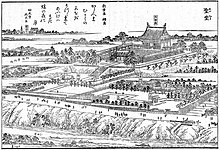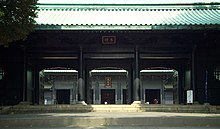Yushima Seidō
The Yushima Seidō ( Japanese 湯 島 聖堂) , literally the "holy hall" in the subdistrict Yushima in the district of Bunkyō in Tokyo was founded as a Confucian temple in the Genroku era of the Edo period .
overview
The Yushima Seidō has its origins in a private educational institution, the Kōbun-in ( 弘文 院 ), that of the neo-Confucian scholar Hayashi Razan (1583-1657) with the support of the shogun Tokugawa Iemitsu on his property in Shinobu-ga-oka (today in Ueno -Park ). In 1632 the Owari-Tokugawa branch founded a temple dedicated to Confucius, the Sensei-den ( 先 聖殿 ), as a cultic center. Razan had to experience how the school was destroyed by flames during the great Meireki fire in 1657. His son Gahō continued the school. The fifth Togugawa Shogun , Tokugawa Tsunayoshi , had the temple moved to its present location, where it became the Taiseiden ( 大成 殿 ) of Yushima Seidō . The Hayashi School of Confucianism was relocating at the same time.
The great fires of 1703 and 1772 brought the Hayashi family's teaching activities almost to a standstill. In 1793 the Shogunate took over the facility and used it as a training center for samurai under the name Shōheizaka gakumonjo ( 昌平 坂 学問 所 ) or Shōheikō ( 昌平 黌 ) for short .
The color scheme of the Taiseiden is said to have been vermilion and verdigris . After it burned down several times for various reasons, the temple was rebuilt in 1799 in the style of the Confucian temple in Mito with black paintwork. This building survived the Meiji period and was declared a Historic Monument in 1922. However , it burned down again during the Great Kanto earthquake the following year. Today's temple is made of reinforced concrete and was designed by Itō Chūta (1867-1954) based on the building around 1799 and built with Chinese support.
Since the Meiji Restoration there have been various institutions on the grounds of Yushima Seidō, such as the Ministry of Education, the Tokyo National Museum and the forerunners of the University of Tsukuba and the Ochanomizu University , whose name recalls their previous location, where they were called "Tōkyō women Lehranstalt ”began.
Is the world's largest statue of Confucius, which in 1975 by on the temple grounds Lions Club of Taipei was donated (Taiwan). There are also statues of the Four Wise Men , by Yan Hui , Zengzi , Kong Ji and Mencius .
Along with the nearby Yushima Tenman-gū , the Yushima Seidō is a mecca for schoolchildren and students who pray for success in their exams.
transport
The Ochanomizu Station and Shin-Ochanomizu Station are nearby.
Remarks
- ↑ Shōhei, Chāngping in Chinese, is the birthplace of Confucius.
literature
- Japan. An Illustrated Encyclopedia . Kodansha 1993. ISBN 4-06-205938-X .
Web links
Coordinates: 35 ° 42 '2.64 " N , 139 ° 45' 58.94" O



